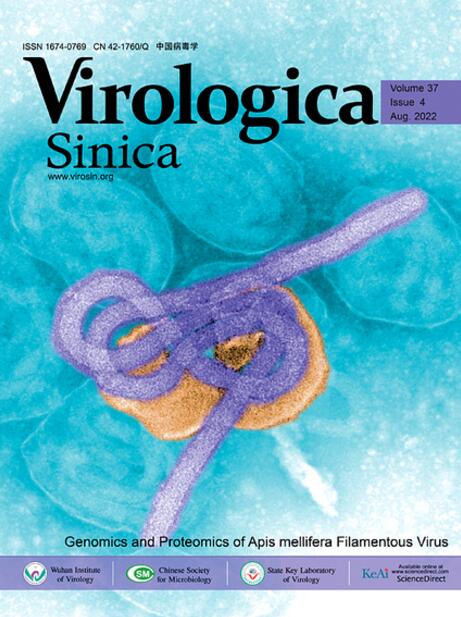Identification of a novel ectromelia virus from rodent: Implications for use as an in vivo infection model for vaccine and antiviral research
IF 4
3区 医学
Q1 Medicine
引用次数: 0
Abstract
Ectromelia virus (ECTV), a member of the Orthopoxvirus genus, serves as both a causative agent of mousepox and a pivotal surrogate model for studying highly pathogenic orthopoxviruses. Although genomic data on ECTV remains limited, we report the isolation and characterization of a novel strain, ECTV-C-Tan-GD01, obtained from rodents in Guangdong Province, China. Nanopore sequencing yielded a complete genome (199 annotated genes, including one gene truncated at the C-terminus) with inverted terminal repeats (ITRs) harboring a conserved hairpin structure. Notably, a frameshift-inducing “G” deletion in the EV159 gene resulted in the truncation of a semaphorin-like protein. In vitro assays demonstrated cell-associated viral replication kinetics, with maximum titers achieved earlier in Vero/HeLa cells (72 h) than in BHK-21/CEF cells (84 h). Murine challenge experiments revealed extreme virulence (LD50 < 1 plaque-forming unit (PFU) via intranasal/footpad routes) and hepatosplenic tropism. Furthermore, ECTV-C-Tan-GD01 exhibited utility in evaluating orthopoxvirus countermeasures: a single dose of vaccinia virus Tiantan (VTT) or non-replicating vaccinia virus Tiantan (NTV) conferred cross-protection, while tecovirimat (ST-246), cidofovir (CDV), and brincidofovir (initially CMX001) significantly reduced viral loads and pathology. This study establishes ECTV-C-Tan-GD01 as a dual-purpose resource for probing orthopoxvirus evolution and advancing therapeutic development.
从啮齿动物中鉴定出一种新的鼠爪病毒:用于疫苗和抗病毒研究的体内感染模型的意义。
电疣病毒(ECTV)是正痘病毒属的一员,既是小鼠痘的病原体,也是研究高致病性正痘病毒的关键替代模型。虽然关于ECTV的基因组数据仍然有限,但我们报道了从中国广东省啮齿动物中分离和鉴定的一种新菌株ECTV- c - tan - gd01。纳米孔测序得到了一个完整的基因组(199个注释基因,包括一个在c端被截断的基因),其反向末端重复序列(ITRs)包含一个保守的发夹结构。值得注意的是,EV159基因中引起帧移的“G”缺失导致信号蛋白样蛋白的截断。体外实验证实了细胞相关的病毒复制动力学,Vero/HeLa细胞(72小时)比BHK-21/CEF细胞(84小时)更早达到最大滴度。小鼠攻毒实验显示出极强的毒力(LD50 < 1斑块形成单位(PFU),经鼻内/足垫途径)和肝脾性。此外,ECTV-C-Tan-GD01在评估正痘病毒应对措施方面显示出效用:单剂量天坛牛痘病毒(VTT)或非复制性天坛牛痘病毒(NTV)具有交叉保护作用,而tecovirimat (ST-246)、西多福韦(CDV)和brincidofovir(最初为CMX001)可显著降低病毒载量和病理。本研究建立了ECTV-C-Tan-GD01作为探测正痘病毒进化和促进治疗开发的双重资源。
本文章由计算机程序翻译,如有差异,请以英文原文为准。
求助全文
约1分钟内获得全文
求助全文
来源期刊

Virologica Sinica
Biochemistry, Genetics and Molecular Biology-Molecular Medicine
CiteScore
7.70
自引率
1.80%
发文量
3149
期刊介绍:
Virologica Sinica is an international journal which aims at presenting the cutting-edge research on viruses all over the world. The journal publishes peer-reviewed original research articles, reviews, and letters to the editor, to encompass the latest developments in all branches of virology, including research on animal, plant and microbe viruses. The journal welcomes articles on virus discovery and characterization, viral epidemiology, viral pathogenesis, virus-host interaction, vaccine development, antiviral agents and therapies, and virus related bio-techniques. Virologica Sinica, the official journal of Chinese Society for Microbiology, will serve as a platform for the communication and exchange of academic information and ideas in an international context.
Electronic ISSN: 1995-820X; Print ISSN: 1674-0769
 求助内容:
求助内容: 应助结果提醒方式:
应助结果提醒方式:


